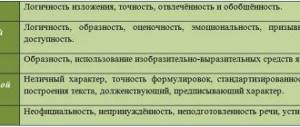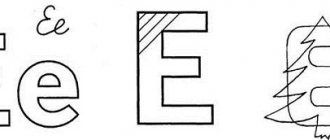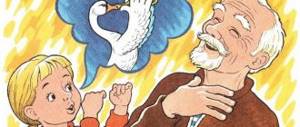What is storytelling?
The narrative tells about events that develop sequentially, from beginning to end, that is, over a certain period of time. The world around us is presented in dynamics, in development, in constant change.
Definition
Narration as a type of speech is a message about the actions of a subject in a certain sequence.
This type of speech, unlike description, is dynamic, its time plans are constantly changing.
The main question asked in the story is: what happened? what's happening?
For example, this is how a river flood is depicted in spring:
Spring this year was late, but friendly. At three days the snow, of which there was a lot of snow, turned into roaring torrents. Having descended through numerous ravines from the mountains, they rushed down, and the river, which had been silent for the entire winter, encased in a two-meter thick layer of seemingly indestructible ice, opened up in one night and awakened from hibernation.
Thunderous peals of bursting ice giants rolled over the river. Freed from her shackles, she moved towards the streams, united with them, flooding everything that was above her level: clearings, vegetable gardens and nearby huts.
The meadows turned into seas. Not only wild ducks swam there, but also migratory swans (M. Alekseev).
Narrative composition
In a narrative text there is always the beginning of an event, its development and completion. Let us indicate the compositional structure of the narrative:
- beginning (beginning of action);
- action development;
- climax (the most poignant, interesting moment);
- denouement (end of action)
Means of linguistic design of narration
Narration is created by the following linguistic means:
- verbs and verb forms predominate;
- verbs in the past perfect form;
- simple and compound verbal predicates;
- circumstances of the time.
Bim carefully and diligently walked through the meadow with a shuttle, looking for scattered cheese, and suddenly, among the different smells of herbs, flowers, earth, and river, a stream of air burst in, unusual and exciting: the smell of some kind of bird, not at all similar to those that Bim knew. There was a smell of something unknown that stirred the blood. Bim stopped and looked back at Ivan Ivanovich. Then, quietly stepping on his paws, he began to approach the unknown, no longer looking at Ivan Ivanovich. The steps became less and less frequent, as if he was choosing a point for each paw so as not to rustle.
Finally the smell turned out to be so strong that it was no longer possible to go further. And Bim froze in place, as if petrified. It was a statue of a dog, as if created by a skilled sculptor. Here it is, the first stand! The first awakening of hunting passion until complete oblivion of oneself (G. Troepolsky).
Functional speech styles
Functional speech styles
Lesson objectives:
generalize and systematize knowledge about speech styles of the Russian language and improve spelling skills.
1. Educational:
-remember and repeat with students the styles of speech and their inherent characteristics;
-learn to apply speech styles according to the situation, learn to generalize and systematize what you have learned.
2. Developmental:
- to update students’ knowledge about functional styles of speech and the scope of their use.
- consolidate the ability to determine the style of speech.
3. Educational:
- fostering a culture of mental work based on such mental operations as: analysis, synthesis, grouping, generalization.
Lesson type: lesson of generalization and systematization of knowledge.
Methods: Explanatory and illustrative, reproductive.
Forms: Collective, frontal, individual
Equipment: handouts (support diagram), multimedia equipment.
During the classes
1. Organizational moment. Teacher's opening speech.
Sit down. Write down the number in your notebooks.
Solve the charade.
My first syllable is a preposition. The second syllable is summer house. And the whole thing is sometimes difficult to solve. (Task)
Yes, today in class we actually have to solve several problems related to text and speech in general.
Every time you write a text or simply communicate with other people, you choose the style of speech that is most relevant for the given moment. There are five styles in total, but the success of your dialogue, both with your interlocutor and with the reader, depends entirely on the correct choice of each of them. For the reader, the style of your presentation is even more important, since when reading a person does not have non-verbal information about you, such as facial expressions, gestures, breathing rate, gaze, etc.
So, today we will remember what text styles exist, what features they have and, of course, we will look at examples of these styles.
2. The stage of updating the subjective experience of students.
General questions on the topic:
— How do you understand the word style?
- Is this word unambiguous?
(Students recite answers to this question)
Teacher's word
(after the answers of the group participants, the teacher gives a more precise definition and history of the origin of this word)
The word style comes from the Greek “stylos” - a stick with a pointed end for writing on a wax-coated tablet. At the other end of the stick there was a spatula, which was used to smooth out the wax if it was necessary to erase what was written. The ancient Roman poet Horace advised to “reverse the style more often,” that is, erase what was written in order to write even better. This is how a new, figurative meaning of the word style appeared - a manner of writing, a method of presentation, a syllable. In this new meaning, the word was borrowed by all European languages.
In the Russian language, a scientific discipline has recently emerged - stylistics, which studies the peculiarities of the use of language means depending on the speech situation.
Did you know that your touch cell phones are also controlled using a “stick”, and it’s called a stylus! And you can also write with a stylus and erase what you wrote to write even better.
– Name what speech styles you know.
(Students list speaking styles).
– How do speech styles differ from each other? The table in front of you will help with this.
(Functional features, linguistic means, communication situation).
Performing an exercise where it is necessary to distribute phrases in accordance with the style of speech.
Exercise 338
Awakening nature, according to a sociological survey, gossip columns, rustling eyelashes, walking around completely dazed, upcoming negotiations, legal proceedings, environmental issues, completed experiment, festive mood, flapping ears, silvery frost, white swan, parliamentary debates, currency corridor, bibliographic index , protect nature, stretched out on a bench.
Check and evaluate your work against the criteria.
Answers: (Colloquial: he walked around completely dazed, his ears flapped, he stretched out on the bench.
Scientific: environmental issues, completed experiment, bibliographic index.
Official business: court proceedings, upcoming negotiations, currency corridor, parliamentary debates.
Journalistic: according to a sociological survey, gossip column, protect nature.
Artistic: awakening nature, rustling eyelashes, festive mood, silvery frost, white swan).
Evaluation criteria: 0 w. – “5”, 1-3 osh. – “4”, 4-5 osh. – “3”, 6 or more – “2”.
These were phrases, but we give stylistic coloring to the text.
– Tell me, how can I prove that a text belongs to a particular style?
(You need to perform a full or partial stylistic analysis).
Do you have notes on the plan for stylistic analysis of the text? Using the memo, we will try to partially perform a stylistic analysis of the text.
Memo “Plan for stylistic text analysis”
- Describe the communication situation (conditions and tasks of speech) in which the text can be used.
- Name the main stylistic features reflected in this text (relaxation - formality, accuracy - vagueness of the title, emotionality - dispassion, concreteness - abstractness, subjectivity - objectivity, imagery - lack of imagery, emphasized logic, appealing speech).
- Indicate the linguistic means (lexical, word-formation, morphological, syntactic) with the help of which the stylistic features you named are revealed in this text.
- Make a conclusion: what style does this text belong to?
Work on the topic of the lesson with text.
Write down the text.
Suddenly something broke through in the still air, the wind rushed strongly and whirled across the steppe with a noise and a whistle. Immediately the grass and last year's weeds rise
If there was a murmur, dust spiraled along the road, ran across the steppe and, /carrying with it straw, dragonflies and feathers, / rose to the sky and clouded the sun. (A.P. Chekhov).
– Explain punctuation marks.
– Determine the topic of the text. (Wind, whirlwind). Windy weather. The beginning of the storm.
– Determine the style of speech. Name the characteristics of style.
(Artistic style. Describes a picture of a strong wind using figurative and expressive means. It reflects such features of artistic speech as concreteness ( the wind in the steppe raised last year’s grass, swirled dust
), imagery (personification:
the wind blew, the grass and weeds raised a murmur, dust swirled
)).
Stage of testing students' knowledge.
There are several texts in front of you. And your task is to determine the style of speech using a reminder of stylistic text analysis. Try this task in pairs.
1. Based on the results of the experiment, we can conclude that the object has a soft homogeneous structure, freely transmits light and can change a number of its parameters when exposed to a potential difference in the range from 5 to 33,000 V. Research has also shown that the object irreversibly changes its molecular structure under the influence of temperatures above 300 K. When mechanically acting on an object with a force of up to 1000 N, no visible changes in the structure are observed (scientific).
2. Incredible discovery! A resident of the remote village of Experimentalovo has invented a new drug that makes hens lay golden eggs! The secret that the world's greatest alchemists have struggled with for centuries has finally been revealed by our compatriot! So far there have been no comments from the inventor, he is currently on a heavy drinking binge, but we can definitely say that the discoveries of such patriots will definitely stabilize the economy of our country and strengthen its position on the world stage as a leader in the field of gold mining and production gold products for decades to come (journalistic).
3. Sidorovich slept poorly at night, every now and then, waking up to the sound of thunder and flashing lightning. It was one of those terrible nights when you want to wrap yourself under a blanket, sticking your nose out for air, and imagine that you are in a hut in the wild steppe hundreds of kilometers from the nearest city.
Suddenly, out of nowhere, the palm of his wife, who was sleeping next to him, ran across Sidorovich’s ear:
“Sleep already, traveler,” she moaned, sleepily smacking her tongue.
Sidorovich turned away offended, pouting. He was thinking about Taiga... (artistic).
4. I, Ivan Ivanovich Ivanov, express my sincere gratitude to the staff, in particular, S.S. Sidorov. and Petrov V.V. for the high level of quality of service and prompt resolution of all controversial issues right on the spot. And I ask you to encourage them in accordance with the terms of the collective agreement of Primer LLC (official business).
5. Have you ever wondered what would happen if the Earth switched places with Jupiter? I'm serious! Would New Vasyuki appear on his rings? Of course not! They're made of gas! Have you really bought such blatant nonsense for even a minute? I won't believe it in my life! And if the Moon fell into the Pacific Ocean, how much would its level rise? You probably think that I am a rare bore, but if I don’t ask these questions, then who will? (colloquial)
6. The lieutenant walked along the yellow construction sand, heated by the scorching daytime sun. He was wet from the tips of his fingers to the tips of his hair, his whole body was covered with scratches from sharp barbed wire and ached from maddening pain, but he was alive and was heading towards the command headquarters, which was visible on the horizon about five hundred meters away (artistic).
7. Yo, dude! If you read this text, you will understand the topic. Energy, drive and speed are what define my life. I love extreme sports, I love thrills, I love when the adrenaline rushes through the roof and blows my mind away. I can’t live without this, dude, and I know that you understand me. I really don't care: skateboard or parkour, roller skates or bike, as long as I have something to challenge. And that's cool! (colloquial)
8. As our correspondent reports, yesterday an unprecedented thunderstorm passed over the central regions of the Penza region. In a number of places, telegraph poles were knocked down, wires were torn, and hundred-year-old trees were uprooted. Fires broke out in two villages as a result of lightning strikes (journalistic).
9. Based on experimental results that indicate that people scan text and do not always view the entire web page, it is advisable to use the inverted pyramid principle and place the conclusion at the beginning of the text (scientific).
10. I took the heavy lists of the novel and draft notebooks out of the desk drawer and began to burn them. This is terribly difficult to do, because paper covered with writing does not burn readily. Breaking my nails, I tore apart the notebooks, standing up, placing them between logs and a poker, and ruffled the sheets. The ashes at times overpowered me, choked the flames, but I fought against them, and the novel, stubbornly resisting, still perished. Familiar words flashed before me, they disappeared only when the paper turned black, and I furiously finished them off with a poker. (art).
Text creation task. Try to convey the content of the following passage using the five styles. Draw conclusions about the feasibility and correctness of such experiments.
For three evenings I tried to solve this problem and only today I realized that I had drawn up the drawing incorrectly. I changed it and it worked right away. I checked the answer - everything is correct.
– Can any text be presented in different speech styles?
(No. For the most part, the text corresponds to a certain style of speech. That is, not every text can be presented in different styles. Only if the style of artistic literature can combine both colloquial and bookish).
Final question.
Why can't a language have one style?
(then our language will be either official, or colloquial, or pretentious. We need to use the style of speech, depending on the speech situation).
Stage of summarizing the lesson.
Teacher's word:
Today we worked hard and were able to complete a number of tasks based on our knowledge. We looked at examples of speech styles in all their, albeit not rich, but diversity. For different situations, different directions will be optimal, but the main thing you should pay attention to when creating a text is the language of the audience that is convenient for it. The emphasis on these two parameters allows your texts to be read in one breath, and, therefore, increases your chances of successfully completing the task assigned to the text.
Get ready for the next lesson, in which we will analyze prose and lyrical texts.
4
Description as a functional-semantic type of speech
Description refers to this type of speech when the permanent or temporary qualities of a phenomenon, object, living creature, place, nature, human condition, etc. are indicated. The description is static and the action does not develop. It is used both in the present tense and in the past and future.
The purpose of the description type of speech is to create the most complete picture of the object being told. Simple sentences are used, mainly with homogeneous members.
Nouns, adjectives and adverbs are used. It is allowed to use verbs, but only in the imperfect form of the past or present tense. Often the description is supplemented with synonyms (agreed and inconsistent).
The description can be objective, in which the narrator indicates the qualities of the object and does not talk about his attitude towards it, or subjective - the author shares his opinion about the subject through speech patterns.
Description composition
The composition of the description consists of three parts:
- beginning (the subject of the description is specified and a general idea of it is created);
- main part (qualities are listed, starting with the most significant);
- ending (the author sums up and expresses his attitude to the subject of the description).
The main thing in the composition is that there is a unity of presentation and views on the object, as well as a logical sequence in its description.
Features of the language design of the description
- Lexical units. This includes all kinds of vocabulary from thematic groups, denoting the names of objects and phraseological units.
- Morphological means. Various parts of speech are allowed, but the most important are nouns, adjectives, and past or present imperfective verbs.
- Syntactic units. Possibility of enumeration, that is, sentences with homogeneous members and complex sentences. Text constructions with parallel types of communication are applicable.




